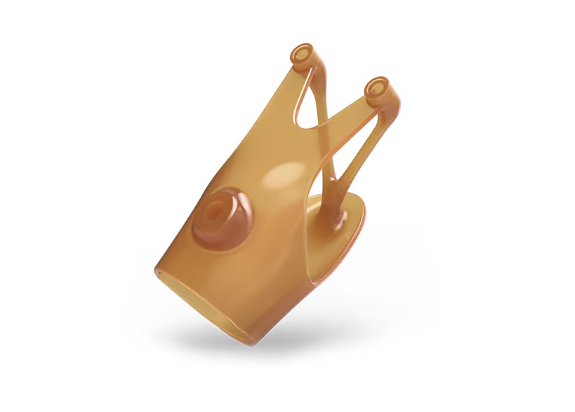Voting closes soon in the 3D Printing Industry Awards 2023. Have your say now!
US 3D printer manufacturer 3D Systems has showcased its new products at Formnext 2023 including materials and printing technologies engineered to help customers meet various application needs.
Accura AMX High Temp 300C, DMP Flex 350 Triple, a novel professional service for C-103, and SLS 300 are part of the lineup. These products are meticulously designed to facilitate the efficient production of high-quality end-use parts. The scope of applications extends across diverse industries, such as automotive, consumer goods, energy, medical devices, semiconductor, and space.
Novel materials portfolio for high-temperature applications
3D Systems’ first product is the Accura AMX High Temp 300C. Boasting an industry-leading heat deflection temperature (HDT) of 300°C, it sets a new standard with nearly double the HDT of existing materials. Accura AMX High Temp 300C’s innovative chemistry eliminates the need for a thermal post-cure, streamlining workflow and reducing time to part-in-hand. This material is ideal for high-temperature component testing and general-use parts in HVAC, consumer appliances, motor enclosures, and stators. According to the company, positive market feedback is already received. General availability for Accura AMX High Temp 300C is scheduled for the fourth quarter of 2023.
“Accura AMX High Temp 300C pushes the offering of SLA into the next level of performance for high temperature resistance,” said Justin Pringle, Managing Director, Prototype Projects. “The material surpasses any other SLA material with its unique HDT above 300C without the need for any thermal post curing. The synergy between this material and its Figure 4 equivalent allows Prototype Projects to offer larger format parts to fulfill new and innovative applications to our customers.”

C-103, a Niobium-alloy refractory material, maintains strength and form at high temperatures, with a service range of 1200°C to 1400°C, making it suitable for aerospace applications. Its low ductile-to-brittle transition temperature provides superior resistance to high-frequency vibrations. Suited for rocket, hypersonic, and jet propulsion, including spacecraft and satellites, C-103 benefits from 3D Systems’ DMP vacuum technology, ensuring a low-oxygen environment crucial for preserving its properties sensitive to O2 exposure.
The material complements NASA‘s GRX-810 super alloy, expanding possibilities for advanced aerospace applications. Application development services for C-103 and GRX-810 are available through 3D Systems’ Application Innovation Group (AIG), while GRX-810 is currently limited to the US.
3D Systems expands portfolio with advanced 3D printing platforms
Introducing the SLS 300 (formerly Wematter Gravity), 3D Systems has launched a closed-loop system designed for smaller settings like offices and labs. This provides a dependable, cost-effective solution for end-use part production. Accelerating in-house production, the SLS 300 ensures both flexibility and reduced costs. It is an easy-to-install ecosystem, operational in under an hour, is compatible with various materials, and eliminates direct powder contact through patented packaging. Sustainable paper and wood-based cylinders maintain a dust-free process.
In addition, 3D Systems took the wraps off the SLS 300 Powder Recycling Station (PRS). This automated unit works in tandem with the SLS 300 to recycle unused material, optimizing investment and cutting production costs. The PRS, equipped with HEPA filters and acoustic dampening, is suitable for various environments. Immediate orders can be placed for the SLS 300, while the Powder Recycling Station is scheduled for availability in the first half of 2024.
Unveiling the DMP Flex 350 Triple, 3D Systems exhibited the latest iteration of its DMP Flex 350 platform. Equipped with three lasers, this system integrates the vacuum chamber design and expands the Removable Print Module (RPM) concept by accommodating two distinct RPM modules with varying build volumes. Supporting a diverse range of materials upon launch, the 3D printer distinguishes itself with a larger build capacity within the same footprint. It introduces a new RPM with dimensions of 350mm x 350mm x 350mm and remains compatible with the standard RPM at 275mm x 275mm x 420mm. As the most compact system supporting a 350mm x 350mm x 350mm build area, the DMP Flex 350 Triple is optimized for the cost-effective processing of various parts like impellers and cooling plates. The inclusion of interchangeable RPMs enhances application flexibility.
Featuring three-laser load-balanced print capability, the system ensures optimal multi-laser load balancing and seamless surface quality scan strategies, eliminating seams or changes in roughness in zones where multiple lasers operate together. Capable of processing eight materials, including aluminum alloys, nickel-based alloys, and 316L stainless steel, the DMP Flex 350 Triple caters to diverse applications in thermal management, lightweight structural uses, and high-temperature corrosion-resistant scenarios. Currently available for ordering, the new RPM with the 350mm x 350mm x 350mm build box is set for general availability in July 2024.

Additionally, 3D Systems offered a preview at the PSLA 270, a new projector-based polymer 3D printing platform. Engineered with the capability to produce larger end-use parts at an accelerated pace compared to similar platforms, this 3D printer holds significant advantages for a wide range of applications in both industrial and healthcare sectors.
Read all the 3D Printing Industry coverage from Formnext 2023.
What does the future of 3D printing for the next ten years hold?
What engineering challenges will need to be tackled in the additive manufacturing sector in the coming decade?
To stay up to date with the latest 3D printing news, don’t forget to subscribe to the 3D Printing Industry newsletter or follow us on Twitter, or like our page on Facebook.
While you’re here, why not subscribe to our Youtube channel? Featuring discussion, debriefs, video shorts, and webinar replays.
Are you looking for a job in the additive manufacturing industry? Visit 3D Printing Jobs for a selection of roles in the industry.
Featured image shows 3D Systems DMP Flex 350 Triple metal 3D printer. Photo by Michael Petch.



